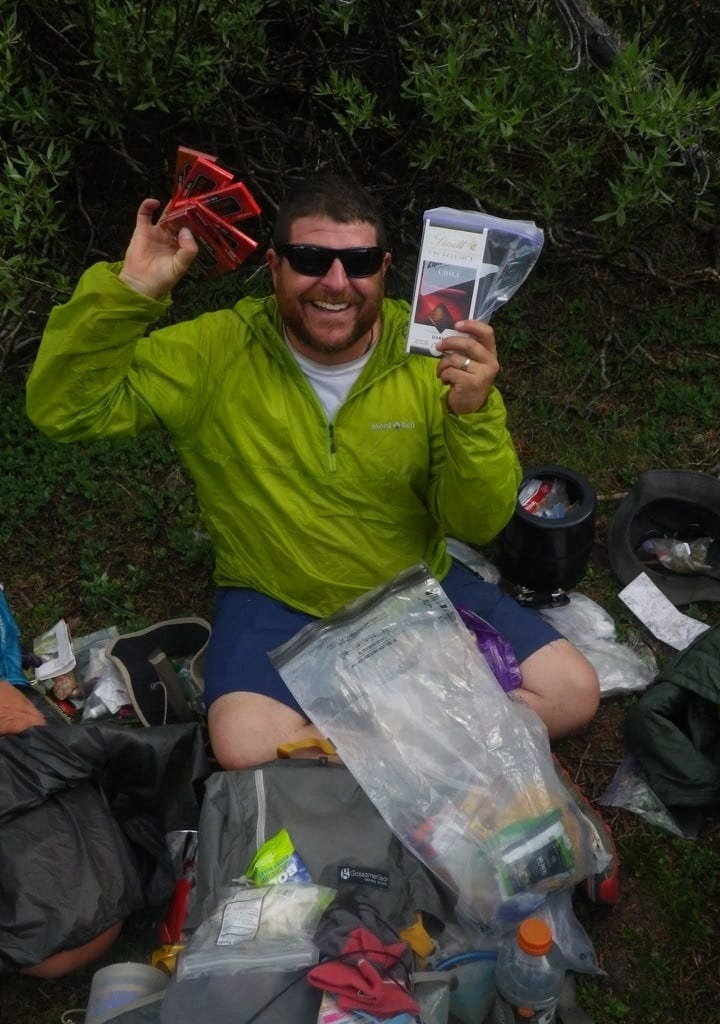Thru-Hiking 101: Intro to Hiking Food
Preparing food for a long backpacking trip can be overwhelming. The ideal hiking food is delicious, non-perishable, calorie dense, easy to prepare, nutritious, and affordable. We provide some tips on how to choose the right hiking food for you!
Related Post: Thru-hiking 101, Tips for Planning your Food in Town

Resupply boxes for a multi-week hike on the Continental Divide Trail.
Photo provided by Dahn Pratt

Whitney “AllGood” La Ruffa enjoying a mountain mocha on the Sierra High Route.
Photo provided by Whitney La Ruffa and taken by Liz Thomas
Start with the food you already eat
Everyone has different dietary needs and preferences when it comes to food whether you are at home or on the trail. I recommend looking at the food you already eat at home as a starting point for your hiking food recipes. With just a few changes, you can enjoy your favorite food in the outdoors.
Visit the grocery store with fresh eyes
Visit your favorite grocery store with an eye towards non-perishable foods. I find this process fun because it involves slowly walking through a grocery store and looking at everything with a new perspective. You will likely see a lot of new food you didn’t know existed.
Typical Grocery Store Foods
To help get you started I created a short list of some grocery store items that backpackers commonly eat. The list includes the unit cost, calories per unit and the calculated cost per 1,000 calories. It is sorted by least to most expensive per calorie of energy. All prices reflect retail prices at Safeway.


Test out the recipes at home
Now it is time to test the hiking food at home. Try to simulate the thru-hiking experience by cooking in one pot and don’t add any ingredients that you will not take with you. It’s very rewarding to optimize the cooking process until the food tastes great. If the food tastes great at home, you will enjoy it in the wilderness. I’m not a believer that everything tastes better in the wilderness. The extra work optimizing dishes at home will make your outdoor experience so much more enjoyable.
Find a special treat or two
Everyone deserves a special treat. Maybe eating a Snickers bar after a bad day will help you feel better and give you a little morale boost. I like to have a variety of treats because it’s fun to have a choice, and my cravings change depending on the situation. It’s also nice to share with friends and other hikers.
Plan on eating more than usual while thru-hiking
You will likely need to eat more while thru-hiking than at home. It isn’t uncommon for weekend hikers to consume 3,000 to 4,000 calories a day. Long-distance hikers can easily consume 4,000 to more than 6,000 calories in a day. The amount of food you need depends upon your body weight, backpack weight, distance you hike, and personal requirements. I recommend starting out with smaller hikes until you understand your personal calorie needs.

Shopping along the Te Araroa, New Zealand
Photo provided by Dahn Pratt

Photo provided by Whitney La Ruffa
and taken by Liz Thomas
A few more tips
- Repackage food into resealable and reusable containers to minimize bulk and garbage. Be sure to clearly label everything and include cooking instructions.
- Purchase bulk food at a warehouse to save 40 to 50%.
- Use coupons and sales to save 20-30%.
Cost per calorie is important, but not all calories are the same!
Just looking at the table provided, one might be tempted to save an enormous amount of money by buying 4-6 months worth of Ramen packets and calling it a day! Besides getting absolutely sick of Ramen, it would also be fool-hearty from a nutritional stand-point.
Calories do not function on a one to one ratio, even when examining cost. It’s also important to consider how the calories will fuel you. For example different foods have different effects on satiating you. This means some foods will give you a greater feeling of fullness. Also some foods are nutritionally well-rounded, while others simply provide calories that may be unhelpful or even harmful to the level of output a typical thru-hiking adventure requires.
When planning a resupply, I always try to strike a happy medium between reducing cost and having calories that provide great nutritional value.